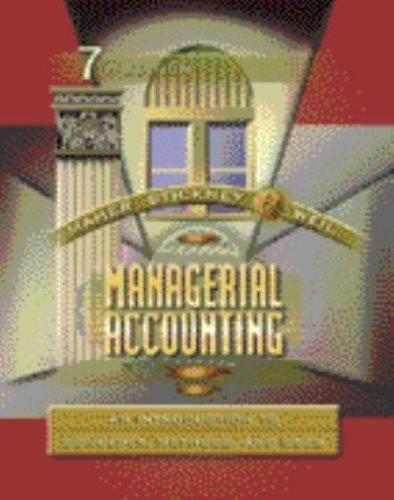Question
1)Bed & Bath, a retailing company, has two departmentsHardware and Linens. The companys most recent monthly contribution format income statement follows: Department Total Hardware Linens
1)Bed & Bath, a retailing company, has two departmentsHardware and Linens. The companys most recent monthly contribution format income statement follows:
| Department | |||||||||
| Total | Hardware | Linens | |||||||
| Sales | $ | 4,070,000 | $ | 3,030,000 | $ | 1,040,000 | |||
| Variable expenses | 1,382,000 | 962,000 | 420,000 | ||||||
| Contribution margin | 2,688,000 | 2,068,000 | 620,000 | ||||||
| Fixed expenses | 2,190,000 | 1,300,000 | 890,000 | ||||||
| Net operating income (loss) | $ | 498,000 | $ | 768,000 | $ | (270,000 | ) | ||
A study indicates that $375,000 of the fixed expenses being charged to Linens are sunk costs or allocated costs that will continue even if the Linens Department is dropped. In addition, the elimination of the Linens Department will result in a 13% decrease in the sales of the Hardware Department.
Required:
What is the financial advantage (disadvantage) of discontinuing the Linens Department?
2)Polaski Company manufactures and sells a single product called a Ret. Operating at capacity, the company can produce and sell 32,000 Rets per year. Costs associated with this level of production and sales are given below:
| Unit | Total | ||||||
| Direct materials | $ | 20 | $ | 640,000 | |||
| Direct labor | 6 | 192,000 | |||||
| Variable manufacturing overhead | 3 | 96,000 | |||||
| Fixed manufacturing overhead | 7 | 224,000 | |||||
| Variable selling expense | 2 | 64,000 | |||||
| Fixed selling expense | 6 | 192,000 | |||||
| Total cost | $ | 44 | $ | 1,408,000 | |||
The Rets normally sell for $49 each. Fixed manufacturing overhead is $224,000 per year within the range of 26,000 through 32,000 Rets per year.
Required:
1. Assume that due to a recession, Polaski Company expects to sell only 26,000 Rets through regular channels next year. A large retail chain has offered to purchase 6,000 Rets if Polaski is willing to accept a 16% discount off the regular price. There would be no sales commissions on this order; thus, variable selling expenses would be slashed by 75%. However, Polaski Company would have to purchase a special machine to engrave the retail chains name on the 6,000 units. This machine would cost $12,000. Polaski Company has no assurance that the retail chain will purchase additional units in the future. What is the financial advantage (disadvantage) of accepting the special order?
2. Refer to the original data. Assume again that Polaski Company expects to sell only 26,000 Rets through regular channels next year. The U.S. Army would like to make a one-time-only purchase of 6,000 Rets. The Army would pay a fixed fee of $1.40 per Ret, and it would reimburse Polaski Company for all costs of production (variable and fixed) associated with the units. Because the army would pick up the Rets with its own trucks, there would be no variable selling expenses associated with this order. What is the financial advantage (disadvantage) of accepting the U.S. Army's special order?
3. Assume the same situation as described in (2) above, except that the company expects to sell 32,000 Rets through regular channels next year. Thus, accepting the U.S. Armys order would require giving up regular sales of 6,000 Rets. Given this new information, what is the financial advantage (disadvantage) of accepting the U.S. Army's special order?
Step by Step Solution
There are 3 Steps involved in it
Step: 1

Get Instant Access to Expert-Tailored Solutions
See step-by-step solutions with expert insights and AI powered tools for academic success
Step: 2

Step: 3

Ace Your Homework with AI
Get the answers you need in no time with our AI-driven, step-by-step assistance
Get Started


